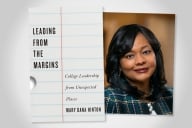You have /5 articles left.
Sign up for a free account or log in.
Wartime has opened up many jobs to women. World War I was no exception. A new book explores how women in science found opportunities in Britain in World War I that were previously denied them, and how these breakthroughs related to the drive for women's right to vote. The book is A Lab of One's Own: Science and Suffrage in the First World War (Oxford University Press). The author is Patricia Fara, a historian of science who is a fellow of Clare College of the University of Cambridge.
Via email, Fara responded to questions about her new book and about women in science today.
Q: How limited was the role for women in science in Britain prior to World War I?
A: Before the First World War, even women believed that they were fitted only for an inferior place in science. In 1897, the principal of Newnham -- one of Cambridge’s only two female colleges -- hoped that "women will do excellent work in the subordinate fields of science … though it is not very brilliant or striking, and will in particular prove excellent assistants." Girls’ schools provided skimpy scientific education, and many parents refused to fund their daughters’ intellectual ambitions. Those who did manage to pursue a scientific career discovered that as undergraduates, they were mocked, excluded from practical classes and provided with inferior accommodation.
In principle, university posts were open to both men and women, but in practice preference was given to men, even in women-only colleges. A tiny number of women did secure positions, but they were deemed unsuitable for addressing audiences of male undergraduates and were frequently channeled into time-consuming tasks of administration and teaching. Moreover, just as in industry, in-built pay differentials meant that experienced women could be hired more cheaply than men, and so often ended up doing lower-grade work. Women were excluded from many professional organizations. In 1906, the physicist Hertha Ayrton won a prestigious medal from London’s Royal Society for her work on electric streetlights, but her nomination for fellowship had already been rejected on the grounds that she was married.
Q: How did the war change the role? Did those leading science organizations see the potential of women, or was it more that smart women saw an opportunity and pursued it?
A: To have got anywhere in science by 1914, a woman needed to be not only smart, but also determined and ambitious. The war did give them the opportunities they had been looking for, but they were often forced to carve out their own routes to success. When Dr. Elsie Inglis offered her medical services in August 1914, the War Office snapped, "My good lady, go home and sit still." Furious at this official rejection, she raised enough money from suffrage organizations for two fully equipped hospital units, staffed entirely by women and including excellent research facilities. Although spurned by Britain, their services were gratefully accepted by two allies, France and Serbia, where they saved many thousands of lives and investigated topics such as food preservation and bacterial infections.
At London’s Imperial College, the chemist Martha Whiteley took charge of the experimental trenches dug in the gardens. Seizing the chance for independent research, other women joined her team, developing explosives -- one was called DW for Dr. Whiteley -- and enduring the pain and scarring caused by testing poisonous gases on themselves. Because of her research into tear gas, Whiteley was celebrated in the press as "the woman who makes the Germans weep." Nearby at the Natural History Museum, the distinguished paleontologist Dorothea Bate was paid a mere assistant’s wages as she took on ever-increasing responsibility for superintending the collections while her male colleagues were away.
Other examples of extraordinary women who smashed conventions include the Stoney sisters. Florence, a medical doctor, specialized in the brand-new field of X-ray diagnosis but found it hard to fight against the military logic that because a woman had never previously been head radiologist, therefore she could not be appointed to the post. Her sister Edith, a physicist, traveled with female medical units to Serbia, working in atrocious conditions to equip hospitals with electricity-generating systems.
Q: After the war, how did the push for women in science get set back?
A: Female scientists, doctors and engineers discovered that opportunities closed down once the war was over. As unemployment rose, priority was given to finding work for men, while women who had successfully performed high-powered jobs were steered back toward domesticity. Women who had enjoyed responsible positions during the war were forced into accepting low-status posts. Less-skilled jobs became redefined as work for women, thus reinforcing the notion that only men were capable of climbing to the top of a professional career ladder.
Even for scientists with high qualifications, all the old stereotypes reappeared: recruitment literature welcomed female graduates not for their brains, but for their “manual dexterity, their delicacy of touch, their conscientiousness and their willingness to bear with a routine under which most men become impatient.” Rather than being replacements for men as in the war, women were now being segregated into separate career tracks: some advertisements even specified that this open-ended research post was suitable for a man, whereas that routine task would satisfy a woman.
For a woman, being a good scientist was not good enough. A careers adviser spelled it out: "When it comes to a permanent post, to obtain equal chances with a male rival, the woman must be obviously a little better."
Q: How do you see the link between women's scientific progress in World War I and women's suffrage in Britain?
A: Women’s work during the war was enormously influential in persuading the government that they should get the vote in 1918. For almost four years, employers and ministers had repeatedly praised the women running factories, hospitals and transport systems. Women’s success during the war transformed perceptions of women’s abilities and social roles. Even those diehards who maintained that women belonged at home with the children could no longer justify their arguments by claiming innate female incompetence. Arthur Conan Doyle (Sherlock Holmes’s creator) changed sides to support the vote, arguing "those who have helped to save the state should be allowed to guide it."
Before the war, science and suffrage were often bracketed together as a twin threat to long-established conventions of female domesticity. When war was declared in August 1914, suffrage groups quickly recognized the publicity that might be generated by switching from protest to patriotism. Benefiting from networks that had been built up over decades, campaigners were ideally placed to respond quickly by raising money and recruiting volunteers. As the male work force diminished, and industry struggled to meet increased demand, women took over the vital tasks necessary for supplying the country’s technological needs. As early as 1916, the minister of munitions boasted that "our armies have been saved and victory assured by the women in the munition factories where they helped to produce aeroplanes, howitzer bombs, shrapnel bullets, shells, machine tools, mines and have taken part in shipbuilding."
Q: Today women are succeeding in science in Britain and the United States in ways that might not have been imagined the early 20th century. But reports are also rampant of sexism and sexual harassment faced by many of these women. Are there lessons for women in science today from the pioneers you profile?
A: Over a century later, equality of opportunity is now firmly entrenched, yet the problems of unequal numbers and gender pay gaps remain unresolved. Even a cursory glance at the statistics reveals that although far more young women are reading science subjects at university than ever before, they are dropping out along the route to the top. The overt differentiation of the past is no longer legal, but it appears that discrimination continues to be practiced.
Not only men but also women need to scrutinize their consciences and explore the behavior patterns and prejudices that they have inherited from the past. Looking back can feel reassuring, because there are clearly dramatic differences between the status of women now and before the First World War. Even so, continuities remain. These are particularly significant when they are concealed, lying dormant, unrecognized and therefore unconfronted. Blind trials show that, just like their male colleagues, women rank anonymized job applications higher when they believe the candidates are men. It seems that even high-achieving women have internalized a feeling of innate inferiority.
Blatant mockery and explicit segregation may now have disappeared, but concealed prejudice can be harder to fight and more keenly felt. Scientists point to subtle ways in which women are made to feel like outsiders: the absence of female portraits on corridor walls, the paucity of women’s works on student reading lists, the near nonexistence of senior women delivering keynote addresses at scientific conferences. When a woman fails to get a lectureship or a research position, it is easy to become oversuspicious -- sometimes the woman is simply not the most suitable applicant. Yet uncertainty often hovers. Before the First World War, suffragists could see what they were fighting against, but modern discrimination is elusive, intangible and insidiously hard to eradicate.








